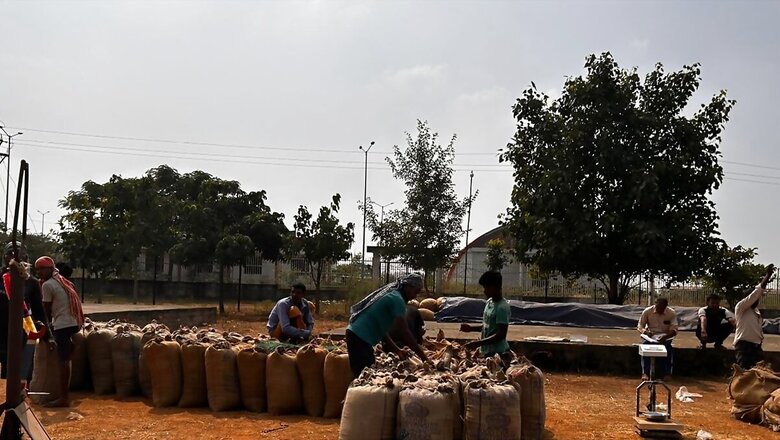
views
The government held the fourth round of talks with the protesting farmers on Sunday in which it proposed diversification of crops in Punjab, which is facing acute shortage of water resources for irrigation.
But the farmers resumed their protest on Wednesday morning after rejecting the government’s five-year proposal under which cooperatives would procure five crops – tur (arhar), urad dal, masur, maize and cotton – at minimum support prices (MSP).
Union commerce and industry minister Piyush Goyal, who held the talks with the farmers, had said, “Cooperative societies like the NCCF (National Cooperative Consumers Federation) and NAFED (National Agricultural Cooperative Marketing Federation of India) will enter into a contract with those farmers who grow ‘tur dal’, ‘urad dal’, ‘masoor dal’ or maize for buying their crop at MSP for next five years… There will be no limit on the quantity (purchased) and a portal will be developed for this.”
Cultivation in Punjab
The Centre is pushing for crop diversification in Punjab, which has more than 80% of its geographical area under rice and wheat, as the state faces widespread desertification.
Growing 1 kg of paddy requires at least 2,500 litres of water, which has led to massive depletion of groundwater in Punjab.
In 2019-20, out of the net sown area of 41.17 lakh hectares, as much as 35.21 lakh hectares was under wheat cultivation while 31.42 lakh hectares was under paddy.
The crops in the Centre’s proposal had very small shares in comparison: 2.48 lakh hectares for cotton, 1.14 lakh hectares for maize, and 33,000 hectares for pulses (both kharif and rabi) in 2019-20, as quoted in an Indian Express report.
Against targets of producing 3.57 million tonnes (MT) of diversified crops in 2021-22 and 4.57 MT in 2022-23, Punjab has produced none.
The area under cotton came down to 2.51 lakh hectares in 2021-22 from 2.91 lakh hectares in 2017-18. Also, the area under maize reduced from 1.14 lakh hectares to 1.05 lakh hectares in the same period in Punjab.
According to the official data, Bathinda had set a target to expand the area under cotton from 70,000 hectares in 2022-23 to 80,000 hectares, but it stopped at 40,000 hectares as farmers lost confidence in the cultivation, as told by Bathinda’s chief agriculture officer Dilbag Singh to Hindustan Times. The loss of 30,000 hectares or 75,000 acres will go towards paddy cultivation. After heavy financial loss over the last few years, farmers are expecting an assured income from growing non-basmati varieties, he added.
An official, quoted by Hindustan Times, said the Punjab government had announced buying moong on MSP in 2022, which led to a jump of 26% than the previous year. But the crop diversification of legumes caused a widespread infestation of whitefly forcing the government to step back.
It should be noted that India imports pulses in order to meet the requirements in the country. Its production in 2021-22 was only 27.69 million tonnes.
The government plans to make India self-sufficient in pulses by 2027 for which it is promoting production through higher MSP and procurement through Price Support Scheme (PSS).
How much does the government procure?
The government announced MSP for 22 crops but the procurement of crops is limited to only few. The Food Corporation of India (FCI) procures cereals, especially wheat and paddy; NAFED mainly procures pulses and oilseeds; and CCI is the procurement agency for cotton.
Punjab accounts for only 5% of total cotton procurement by CCI. Andhra Pradesh had the highest share with 34.01 lakh bales during the 91.90 lakh bales procured by CCI in 2021-22. Punjab’s share was only 5.36 lakh bales that year but it was higher than 3.58 lakh hectares in 2020-21.
In 2022-23, NAFED procured 29.64 lakh tonnes of pulses at the MSP under PSS, (benefiting 13.77 lakh farmers), and 57,754 tonnes under PSF. Of the total quantity procured by NAFED, the largest share (84.59 lakh tonnes) was of gram, followed by moong (12.59 lakh tonnes).
According to the CACP’s report on Price Policy for Rabi Crops Marketing Season 2024-25, “Due to record production of gram and depressed market prices during the last two seasons, Government procured about 25.6 lakh tonnes of gram during RMS2022-23 and 22.3 lakh tonnes (as on June 1, 2023) in RMS2023-24 under Price Support Scheme (PSS). Total procurement of pulses increased from about 29.6 lakh tonnes in 2021-22 (KMS2021-22 and RMS2022-23) to about 30.2 lakh tonnes in 2022-23… [But] since there is no assured mechanism for disposal of pulses procured under the PSS…NAFED disposes of the stock of pulses in open market at a price much lower than the MSP.”




















Comments
0 comment